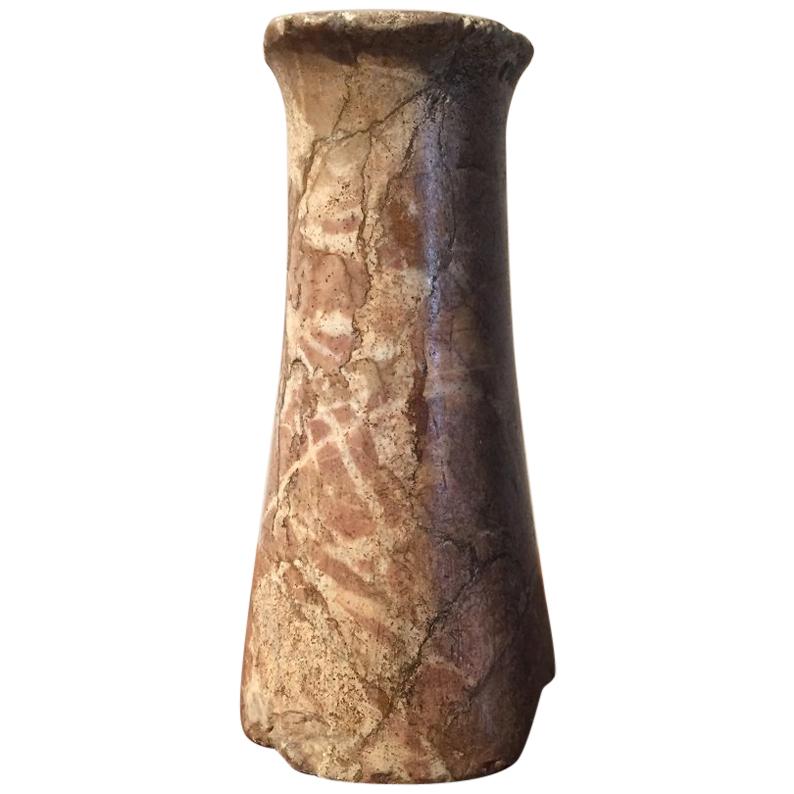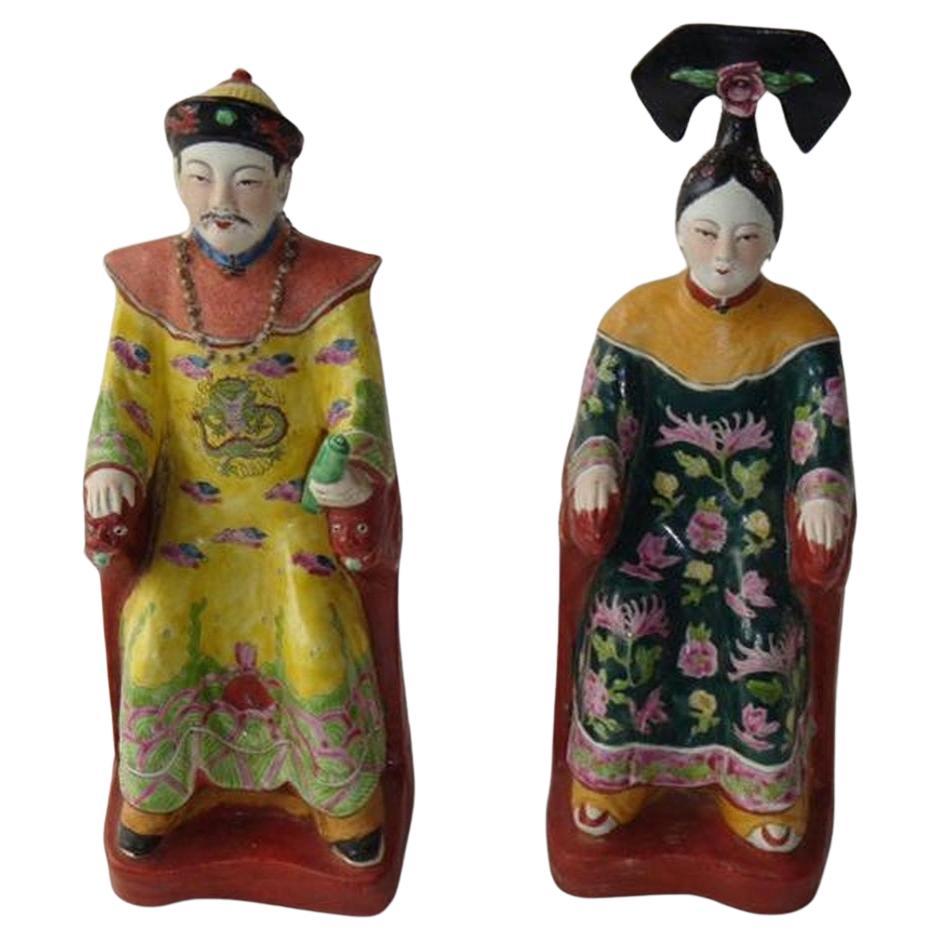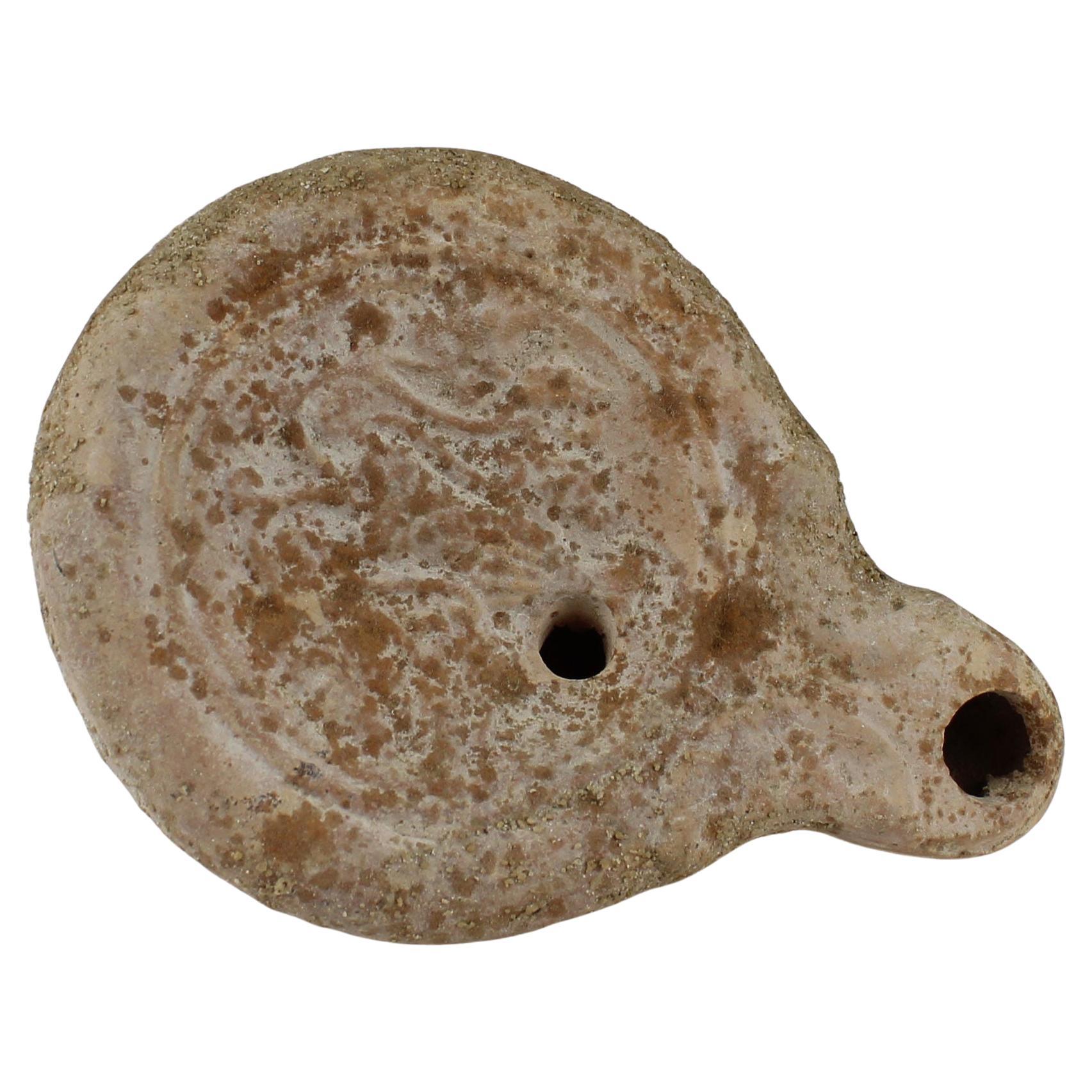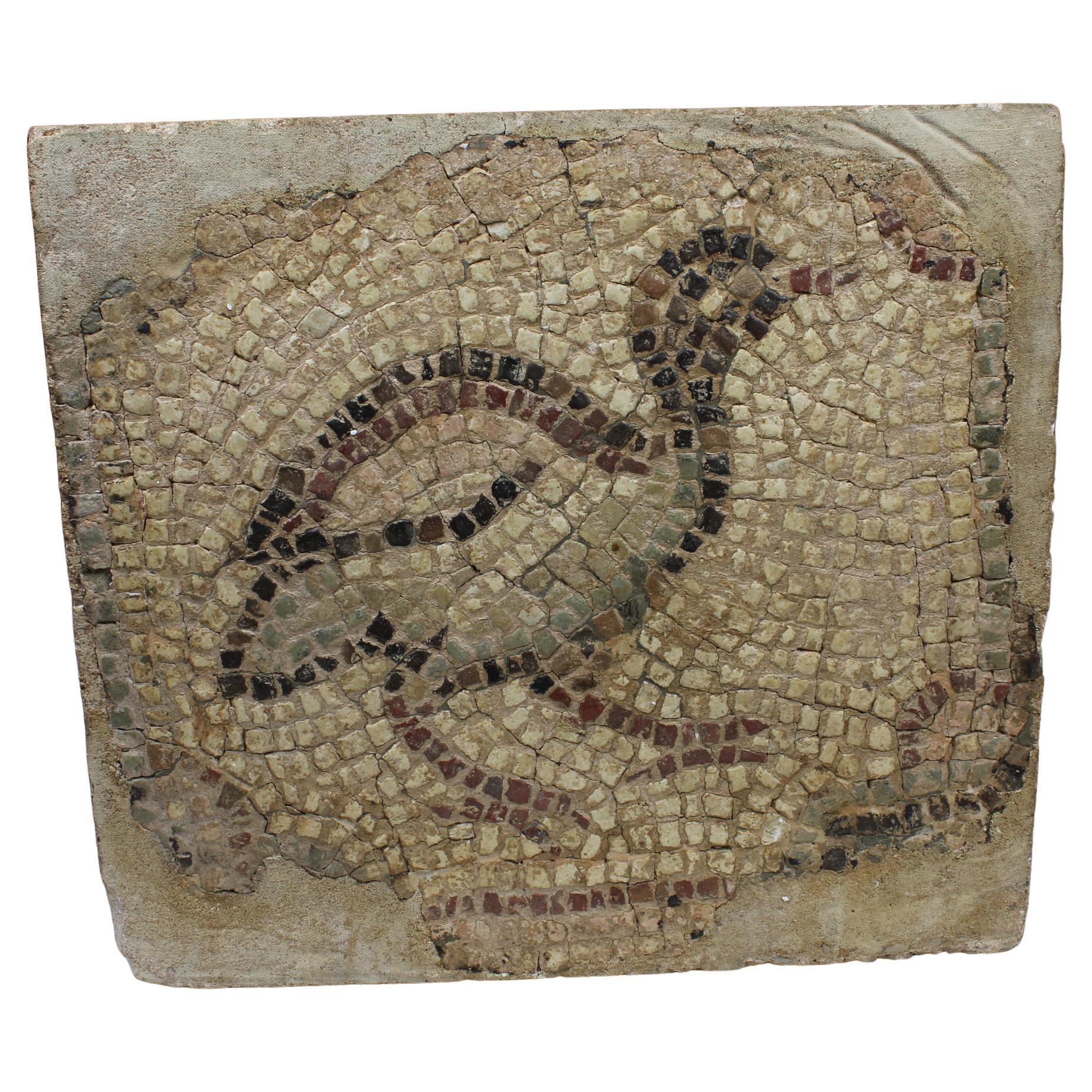Items Similar to A Rare and Important Late Roman Marble Column
Want more images or videos?
Request additional images or videos from the seller
1 of 7
A Rare and Important Late Roman Marble Column
About the Item
A Rare and Important Late Roman Marble Column
With a fluted spiral central column shaft rising to a carved integral capital with Corinthian ‘acanthus’ leaf decoration, the base with a relief carved Chariot and Charioteer
White marble
Eastern Roman Empire
Circa 300 AD
SIZE: 288cm high - 113½ ins high / 9 feet 44 ins high
PROVENANCE:
Ex Private Diplomatic Residential London Property, since 1980’s
Ex Private UK collection
‘Corinthian’ describes an ornate column style developed in ancient Greece and classified as one of the ‘classical orders of architecture’. The name comes from a ‘myth’ about a young Corinthian girl who died tragically, and an ‘acanthus plant’ which ‘sprouted’ from her grave, with the ‘leaves’ of the capitals, resembling those from the grave. The columns are usually tall and slender, with fluted shafts and include bases.
Favourite charioteers and horses were received by the public with loud applause, and in inscriptions the name of the victorious horse is frequently mentioned together with that of the charioteer. Cappadocia, Sicily, Spain and Africa were celebrated for their race horses whose pedigree, age and names were meticulously recorded.
Charioteers were free citizens, but over time the occupation, although never considered dishonourable like that of the gladiator, came to be regarded as unworthy of a free Roman. It was therefore left to be taken up by mostly slaves and freedmen who were trained at special schools. These were comprised of a complete staff of chariot makers, tailors, shoemakers, surgeons and teachers, and were kept by one or several owners, ‘domini factionum’, who would let out both the chariots and the charioteers to the highest bidders of the parties in control of the circus. Victorious charioteers received silver crowns, valuable garments and money, and the successful often made large fortunes and became ‘domini factionum’.
- Dimensions:Height: 113.5 in (288.29 cm)Diameter: 19.685 in (50 cm)
- Materials and Techniques:
- Place of Origin:
- Period:
- Date of Manufacture:Circa 300 AD
- Condition:Wear consistent with age and use. Minor structural damages.
- Seller Location:London, GB
- Reference Number:1stDibs: LU9363236847462
About the Seller
New to 1stDibs
Joined in the past six months.
No Reviews Yet
Vetted Seller
These experienced sellers undergo a comprehensive evaluation by our team of in-house experts.
Established in 1989
1stDibs seller since 2023
- ShippingRetrieving quote...Ships From: London, United Kingdom
- Return PolicyA return for this item may be initiated within 14 days of delivery.
More From This SellerView All
- An Over Life-Size Powerful Roman Male Portrait Head of Constantine the GreatLocated in London, GBAn Over Life-Size Powerful Roman Male Portrait Head of Constantine the Great (c.272 - 337) Wearing the ‘Imperial Oak Wreath’ the decorative border of his ‘tunic’ can still be clearly seen on the left hand side Marble Italy Early 4th Century AD SIZE: 38cm high, 24.5cm wide, 25cm deep - 15cm high, 9¾ ins wide, 10 ins deep PROVENANCE: Ex Private collection, Cambridge, England note: For a very similar over life-size portrait head of Constantine I (the Great) wearing an identical wreath dating from the early 4th century AD see: Yorkshire Museum, York, inv. no. ‘YORYM’ 1998.23. Found in ‘Eboracum’ (York) in 1823 LITERATURE: Rinaldi Tufi, S., Yorkshire. ‘Corpus Signorum Imperii Romani (Great Britain)’; vol. 1, fasc. 3, Yorkshire. Oxford University Press, 1983; 23, no. 38, pl. 12 In AD 306, Constantine was hailed emperor in the Roman city of York; he was the first emperor to convert to Christianity. Born in Naissus, the son of Flavius Constantius, and Helena, a woman of low birth and a christian. Following his campaigns in the eastern provinces, Constantine was recalled in 305 AD to fight alongside his father in the province of Britannia. After his father’s death in 306 AD, Constantine was acclaimed as ‘imperator’ by his army at Eboracum (York) eventually being declared victorious after the civil wars against emperors, Maxentius and Licinius to become sole ruler of the Roman Empire in 324 AD. Constantine’s Christian belief cannot be underestimated, establishing the foundations of ‘Western Christendom’. In 313 AD he was influential in the proclamation of the ‘Edict of Milan, declaring tolerance of Christianity within the Roman Empire. The Church of the Holy Sepulchre, the purported site of Jesus’s tomb...Category
Antique 15th Century and Earlier Italian Classical Roman Antiquities
MaterialsMarble
- A Very Rare and Important Marble Relief of the ‘Resurrection of Christ’Located in London, GBA Very Rare and Important Marble Relief of the ‘Resurrection of Christ’ Attributed to the Master of the Mascoli Altar Marble Venice, Italy Second half of the 15th Century SIZE: ...Category
Antique 15th Century and Earlier Italian Renaissance Figurative Sculptures
MaterialsMarble
- A Rare and Important Sarcophagus ‘Wedding’ CasketLocated in London, GBA Rare and Important Sarcophagus ‘Wedding’ Casket Attributed to the Embriachi workshop / and the so-called: Master of the ‘Susanna Two’ Bone, Wood, P...Category
Antique 15th Century and Earlier Italian Decorative Boxes
MaterialsMetal
- A Fine Gandharan Head of a BuddhaLocated in London, GBA Fine Gandharan Head of a Buddha Stucco with ‘earth pigment’ Some old ‘restoration’ to the nose Afghanistan 3rd Century AD Size: 26cm high, 14.5cm wide, 14cm deep - 10¼ ins hig...Category
Antique 15th Century and Earlier Afghan Antiquities
MaterialsStucco
- A Rare and Historically Important Artefact Recovered from HMS Adventure in 1775Located in London, GBA Rare and Historically Important Artefact Recovered from HMS Adventure in 1775 after Captain James Cook’s Second Voyage to the Pacific A ‘coconut husker’ made by a ship’s carpenter aboard HMS Adventure in the style and design of a Native Islander’s ethnographical ‘coconut husker’ An engraved and inscribed copper plaque: A memento from The Sandwich Islands Coconut Husker used aboard HMS Adventure and recovered from The Royal Dockyard Deptford 1775 Oak, iron, brass, copper, handmade iron screws Fine rich colour and patina England / Sandwich Island 18th Century SIZE: 15.5cm high, 49.5cm long, 20cm wide (max) - 6¹⁄₈ ins high, 19½ ins long, 7⁷⁄₈ ins wide (max) Provenance: Found in a Scottish attic after centuries of lying hidden in a crate Ex Private Scottish collection Captain James Cook’s second voyage aboard the Resolution and accompanied by HMS Adventure set sail in July 1772. The discovery of the southern eight islands of the Sandwich Islands group was in 1775. The given name was chosen in honour of John Montagu, 4th Earl of Sandwich, First Lord of the Admiralty. The copper plaque and inscription however should not be read as The Sandwich Islands ‘Owhyhee’ (The Hawaiian Islands) which were later discovered on January 18th, 1778, on Captain Cook’s third voyage. Rather the inscription refers to ‘South Sandwich Islands’ lying to the south east of South Georgia and only renamed later with the word ‘South’ to distinguish them from the ‘Sandwich Islands’ now known as the Hawaiian Islands. Not withstanding during Cook’s second voyage he visited Easter Island, Tahiti, Society Islands, Niue, Tonga, New Hebrides, New Caledonia, Norfolk Islands, Palmerston Island and South Georgia. The crew onboard having been exposed to various types of ‘coconut huskers’ adapted those designs into the example we now see, having been rescued from HMS Adventure in 1775. A rare example of 18th century cross...Category
Antique 16th Century American Tribal Art
MaterialsBrass, Copper, Iron
- A Fine and Rare Scroll PaintingLocated in London, GBA Fine and Rare Scroll Painting Depicting the European Hendrik Doeff (1764 - 1837) standing, holding a ‘red lacquer’ walking cane, together with his dog and his young Javanese boy-se...Category
Antique Early 19th Century Japanese Paintings and Screens
MaterialsSilk, Paper
You May Also Like
- Bactrian Marble Column IdolLocated in Vosselaar, BEBactrian marble column idol, circa 3000-2000 Bc. It has a elegant tapering form with a undeep groove running on the top and bottom. The marble is a breccia type with striking vains i...Category
Antique 15th Century and Earlier Afghan Archaistic Antiquities
MaterialsMarble
- Pair of Rare Important Estate Emperor and Empress Chinese Porcelain FiguresLocated in New York, NYThe Following Item that we are offering is A Rare Pair of Estate Chinese Porcelain of a Seated Emperor and Empress. Handpainted beautifully with Outstanding Detail and Beautiful Arra...Category
20th Century French Antiquities
MaterialsPorcelain
- Empire Style Pair of Italian Green Marble and Gilted Bronze ColumnsLocated in LEGNY, FRBeautiful and rare Empire style pair of Italian green marble and gilded bronze columns. Napoleon III period. Bronze Medicis on the top removable thanks to a metal rod. There are me...Category
Antique 1880s Italian Napoleon III Pedestals and Columns
MaterialsMarble, Bronze
- Extremely Rare Late Shang Dynasty Inlaid Bronze Gu VesselLocated in Austin, TXOf classic trumpet form, with a round, splayed foot, narrow, waisted body and wide, flaring mouth. Two sets of large, well defined fanged and horned taotie masks cast in high relief...Category
Antique 15th Century and Earlier Chinese Archaistic Antiquities
MaterialsJade, Malachite, Bronze
- Roman oil lamp with leaves and fruitLocated in EL CAMPELLO, ESITEM: Oil lamp with leaves and fruit, Type Bussiere B III 1 MATERIAL: Terracotta CULTURE: Roman PERIOD: 1st – 2nd Century A.D DIMENSIONS: 20 mm x 65 mm x 90 mm CONDITION: Good condit...Category
Antique 15th Century and Earlier Italian Classical Roman Antiquities
MaterialsPottery
- Roman mosaic depicting a birdLocated in EL CAMPELLO, ESITEM: Mosaic depicting a bird MATERIAL: Tesserae CULTURE: Roman PERIOD: 3rd Century A.D DIMENSIONS: 400 mm x 440 mm x 40 mm CONDITION: Good condition PROVENANCE: Ex Swiss private col...Category
Antique 15th Century and Earlier Italian Classical Roman Antiquities
MaterialsMarble
Recently Viewed
View AllMore Ways To Browse
West Germany Art Pottery
Dog Ear
Large Divider Screen
Brass And Walnut Bedside Table
Rustic French Oak Table
Cenedese Vintage Midcentury
England Umbrella Stand
Light Oak Art Deco Furniture
Set Of 14 Midcentury Chairs
Small Salmon Rugs
Stunning Art Deco Desk
Turned Wood Side Table Black
Persian Tabriz Pictorial Rug Persian Tabriz Pictorial Rug
Pressed Leaves
Arm Chair With Wooden Frame
Two Piece Walnut Sofa
Vintage Scandinavian Rya
Antique Bronze Sculptures Female





